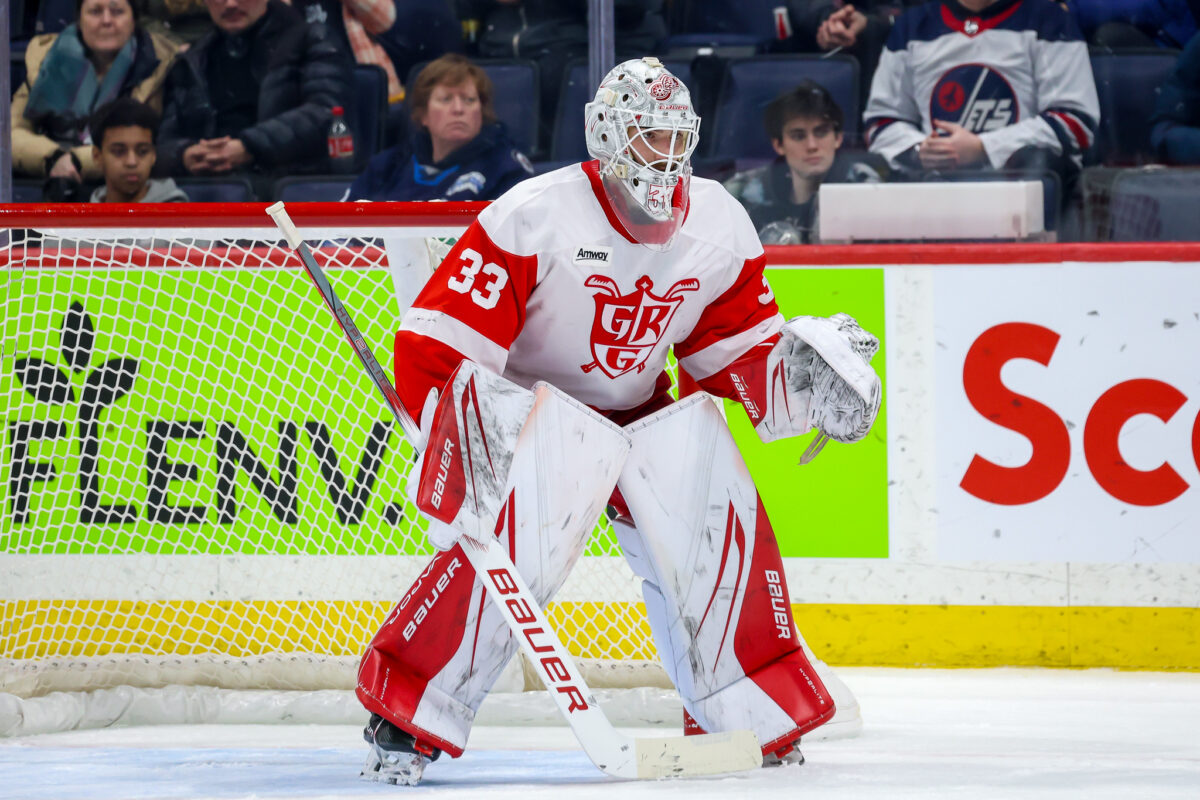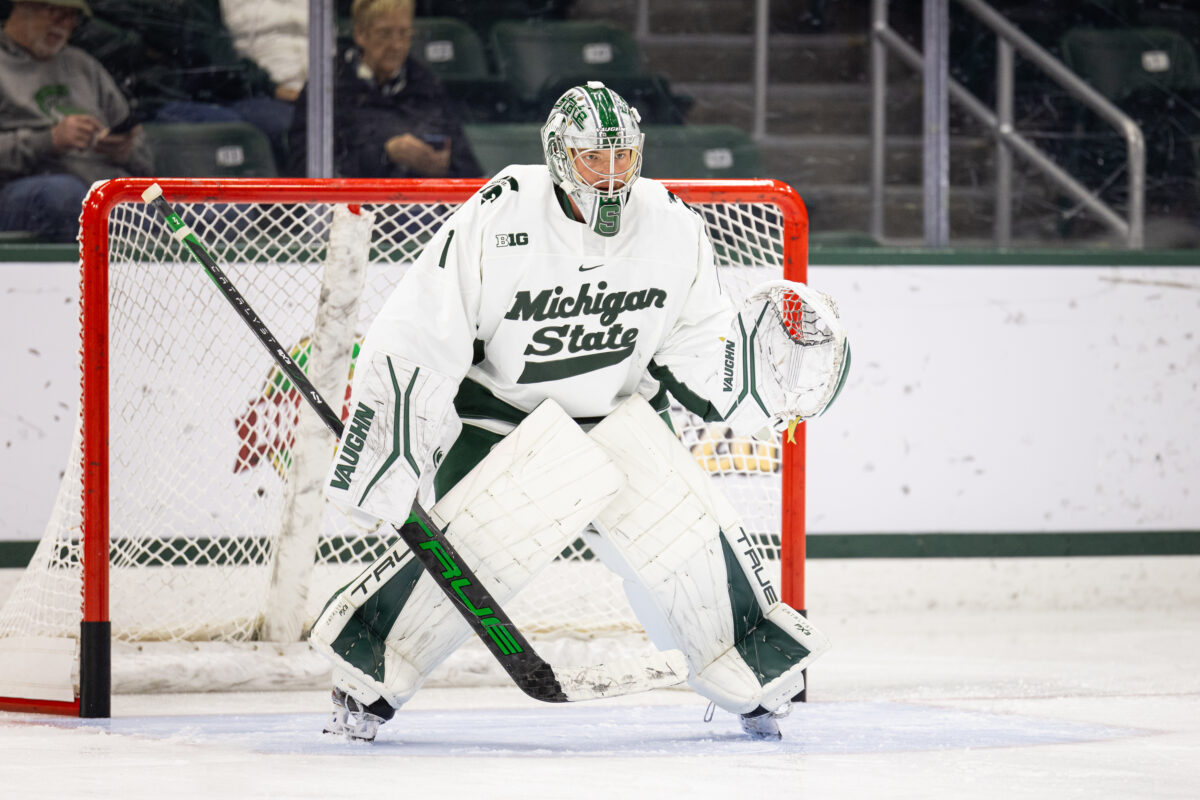The Detroit Red Wings have been missing a strong starting goaltender for many years now, with the team’s season-long save percentage landing below league average in 10 of the last 11 NHL seasons. Plenty of goalies have come and gone, from Petr Mrazek and Jonathan Bernier, to James Reimer and Alex Nedeljkovic.

The organization has made plenty of attempts to shore up the position through trades and free agency, but nothing has seemed to stick. Detroit sought to solve that problem in the 2021 NHL Draft, trading up to select Sebastian Cossa with the 15th overall pick. Cossa was a bit of a late riser as a prospect, shooting up draft boards with an incredible stat line in the Western Hockey League (WHL) and a massive frame that caught the eye of many scouts.
Then, the Red Wings decided to use one of their five top-50 picks in the 2023 Draft to add Trey Augustine, a goaltender prospect who is an excellent stylistic foil to Cossa. Where Cossa is the big, athletic goalie with a fiery intensity, Augustine is a bit of a smaller goalie, with the focus, calmness, and technical game to be an effective NHL goaltender.
Related: Why the Red Wings’ Quiet Offseason Was the Right Call Long Term
While neither are likely to be impactful NHL goalies in the next 12 months, I think it’s time we take a look at both of their progress and set some realistic expectations for their continued growth, and for their NHL timelines.
Cossa’s Unorthodox Development
Cossa is a 6-foot-6 goaltender (was 6-foot-4 when drafted) with explosive movement side-to-side that allows him to cover the bottom of the net really well. He fills a ton of the net while standing, and there aren’t many professional hockey players in North America who he can’t look around, or even over, at the net front. Cossa’s hands naturally sit pretty high in the net, and he’s got a really strong ability to make stops with them. His positioning is generally solid as well, since his powerful lower-half lets him adjust to cross-ice passes quickly.
The biggest issues in Cossa’s game are his five hole and tendency to get a bit wild in the crease during scrambles. Both of these issues are evidently understood by Cossa however, as I’ve seen some good growth in both areas since his draft season. Since he stands at 6-foot-6, Cossa isn’t the fastest at closing his five-hole, making it the highest-percentage shot location for a ton of shooters. His lower-body power can be a bit of a double-edged sword in scramble plays since he launches so forcefully off his post that he can lose his position a bit.
After being drafted on the heels of a .941 save percentage (SV%) season, Cossa has had three consecutive seasons with a .913 SV%, in the WHL, ECHL, and then AHL. His first post-draft year in the WHL was a bit of a disappointment, with his numbers taking a meaningful dip despite plenty of team success. However, there wasn’t anything I saw in his play that materially changed the projection on him as a massive, athletic goalie prospect.
Cossa followed that up by joining the Grand Rapids Griffins in the AHL before being sent down to the ECHL to earn more consistent minutes with the Toledo Walleye. To some, this was apparently a death sentence to Cossa’s status as a high-end NHL prospect. Granted, it’s virtually unheard of for a top goalie prospect to spend a year in the ECHL, but it was clear that the move was meant to give him consistent starts rather than the sparse work load he would have seen in the AHL.
Last season, Cossa made the jump to the AHL full time. It appeared that the plan was for him to split starts in a goalie tandem with Michael Hutchinson, though Cossa took the reins as the clear 1A goalie by the end of the season. Shortly after the calendar flipped to 2024, Cossa went on an absolute tear, earning points in a franchise-record 19 consecutive starts (13-0-6)! He graded out extremely well statistically, proving himself as an above average starting goalie in the AHL at age 21.
A Red Wings team with Ville Husso, Alex Lyon, Cam Talbot, and Jack Campbell on the roster won’t give Cossa many (if any) NHL games during the 2024-25 season, so let’s get an idea for when he could land in Detroit.
I don’t expect Detroit to permanently graduate Cossa to the NHL until they’ve got the roster space and are confident he can handle a full-time backup goalie role. In the meantime, conventional wisdom says that the best development path for a goalie includes playing lots of games, so I think Cossa will remain in Grand Rapids for the entirety of next season. That will most likely be in a tandem with one of Campbell of Lyon, but if either are claimed on waivers, Cossa could easily handle being the starter anyway for the Griffins.
After another year as a 1A tandem goalie, Cossa could potentially push for an NHL spot, but will likely be a high-workload starter in the AHL who is called up on relief duty in the case of any injuries in the NHL. He will still be waiver-exempt in the 2025-26 season, so it would be a valuable situation for management to be in where they can bring him in for NHL relief starts while also allowing him to get tons of AHL reps in.
In this case, I think a realistic path to the NHL includes Cossa seeing his first NHL ice in the 2025-26 season and then joining the team on a full-time basis the following year. If Cossa’s strong development curve continues in the AHL this coming season, I see a world where he could land as the full-time backup for Cam Talbot in the 25-26 season as well. It’s not uncommon for high-end goalies to take a bit longer to be brought into the fold, just look at guys like Thatcher Demko and Connor Hellebuyck who only became NHL starters at ages 25 and 23 respectively.
Augustine’s Steady Play Continues
Augustine is a very different type of goaltender, with a quiet focus and calmness that is a bit more typical when it comes to high-end NHL goalies. He’s got an incredible poise for someone so young, and has shown incredibly well when the stakes are raised, such as in the World Junior Championship or even the Men’s World Championship where he got a few games for Team USA this Summer.
Augustine’s game is incredibly polished already and doesn’t show signs of any real weakness. His lack of size (6-foot-1) hindered his draft stock a little back in 2023, but there’s nothing in his game that worries you from an NHL projection standpoint. He may not be the most explosive athlete, and some more size would help him fill the net a bit, but Augustine has a really strong chance to become at least a good backup goalie in the NHL with time.
The analysis of Augustine in his draft year was a bit tough, as his record might suggest he’s a generational goalie, but that was largely due to the especially strong crop of forwards in the United States National Team Development Program that season (NTDP). He was excellent all year, but the counting stats out of the NTDP can be a bit misleading at times.
However, Augustine’s excellent positioning, advanced ability to track pucks through traffic, and rebound control were all noticeable in his draft year, and those skills have only continued to develop. In the NCAA with Michigan State University, Augustine had a phenomenal freshman season, with a .915 SV% across 35 games played. His performance at the World Juniors in January was impressive as well, leading the tournament in SV% and goals against average en route to winning a gold medal.
After a really strong year, Augustine was invited to join Team USA’s senior team at the World Championships where he actually landed some real playing time. Statistically, he showed really well on a team that also had NHL tandem goalies like Detroit’s Alex Lyon, Pittsburgh’s Alex Nedeljkovic, and one of last season’s breakout performers in Charlie Lindgren (Washington Capitals). Even aside from the numbers, Augustine looked calm and poised as ever when he was hit the ice, earning a convincing victory of Poland in the Group stage and coming in for relief on a couple of other occasions.
Augustine is returning to Michigan State next Fall, where he will be one of the NCAA’s top goalies. He is still eligible for the upcoming World Juniors beginning in December 2024, so I expect he’ll be an absolute nightmare for any team that’s matched up against an already formidable Team USA roster that should include the likes of Ryan Leonard, James Hagens (2025 Draft), Zeev Buium, and many more high end NHL prospects.
Now for the timeline. Looking at some recent highly touted goalies coming out of the NCAA, it’s reasonable to assume that this upcoming year will be Augustine’s last at the college level. Spencer Knight, Jake Oettinger, and Demko all found themselves playing professionally for their entire age-20 season, with Knight jumping right into the NHL for some of that season.
He won’t have all that much to prove after another season in the NCAA, and would likely be best served starting the 2025-26 season in Grand Rapids. You may have noticed, that would put both Cossa and Augustine together as a tandem of sorts with the Griffins roughly 14 months from now, and that is something I think the organization would be delighted to see.

If both goalies have really strong years in 2024-25, there’s a chance Cossa gets the backup spot in Detroit and Augustine gets the starter’s net in GR for the following year, but I think that’s a bit of a rosy projection at this point. With my projection of Cossa ending up as a full-time NHL goalie in the 2026-27 season, that would likely mean Augustine takes the starter spot in the AHL, before joining Cossa with the Red Wings the following year.
As Always, Patience Is Key With Goalies
To summarize, I think the most realistic timeline for both goalies sees Cossa establish himself in the NHL full-time in the 2026-27 season, with Augustine managing the same in the 2027-28 season, giving Detroit their goaltending tandem of the future. This would fit well with the timelines for the rest of Detroit’s top prospects, with guys like Nate Danielson, Axel Sandin Pellikka, and Marco Kasper likely established as full-time NHLers at that point.
There’s obviously a ton of development to go for both prospects before they’re full-time NHL goalies, but I truly believe both of them have the potential to be strong contributors at hockey’s highest level. Cossa has a bit more upside, but is a more volatile player, while Augustine’s game is a lot safer and more consistent despite a slightly lower ceiling. I know going a few more years without a high-end young goalie in the NHL would be a tough pill for many fans to swallow, but I think the eventual tandem of Cossa and Augustine will be formidable enough to be worth the wait.